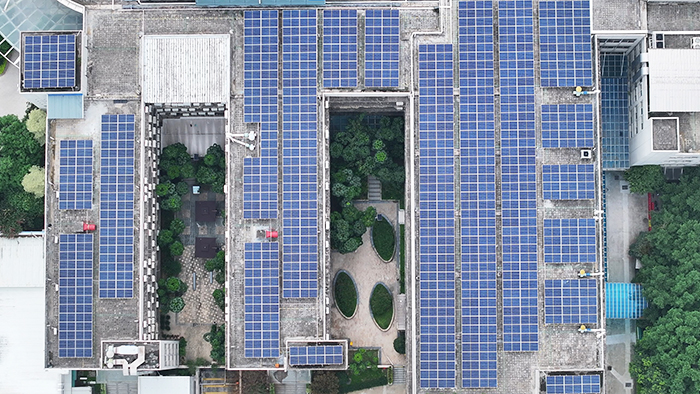In the wave of global energy transition and green development, commercial and industrial distributed solar PV has become a key driver of sustainable economic and social development due to its unique advantages.
1. Advantages of Commercial and Industrial Distributed Solar PV
Significant Economic Benefits
Commercial and industrial distributed solar PV systems utilize rooftop space efficiently, adopting a "self-consumption with surplus power sold to the grid" model, greatly reducing operational costs and enhancing economic returns. For example, companies like China Southern Power Grid have implemented this model to achieve stable power supply and additional revenue from selling excess electricity. For high-energy-consuming manufacturing businesses, installing a solar PV system can lead to significant electricity cost savings, and even profitability. A 1MW solar PV system, with 80% self-consumption and 20% surplus power sold to the grid, can pay for itself within 4-5 years, with total returns exceeding 15 million RMB over 20 years.
Outstanding Environmental Benefits
As a representative of clean energy, distributed solar PV systems significantly reduce carbon emissions, helping businesses achieve green transformation and align with global sustainability trends. Their adaptability to various business needs and decentralized layout enable them to respond flexibly to different energy demands, improve energy efficiency, and contribute to meeting corporate energy-saving and emission reduction goals. This not only helps avoid hefty fines but also enhances the company’s brand image and social responsibility.


Wide Application Scenarios
Distributed commercial and industrial solar PV systems are widely applicable, including on factory rooftops, logistics parks, industrial zones, hospitals, schools, and shopping malls. Despite varying rooftop sizes, the sheer number of potential sites can result in substantial power generation capacity through centralized construction and management. Particularly, large factory rooftops with high electricity consumption are ideal for building distributed solar PV systems. Utilizing idle rooftop space not only meets a company’s energy needs but also generates additional revenue through selling surplus power to the grid.
Temperature Regulation and Improved Comfort
Solar panels have an insulating effect, and installing a solar PV system can effectively reduce the internal temperature of factories, improving the comfort of the working environment and ensuring the stable operation of production equipment. For many manufacturing businesses, this can lead to significant savings on cooling costs.
Stable Power Supply
During power shortages or peak electricity usage in the summer, commercial and industrial solar PV systems can serve as a backup power source, ensuring uninterrupted production. The alignment of solar power generation with peak business electricity demands further helps meet energy needs and reduces the risk of power outages.
2. Detailed Development Process for Commercial and Industrial Distributed Solar PV
The development process of a commercial and industrial distributed solar PV system involves four main stages: preliminary preparation, investment filing, construction, and grid connection and acceptance. Below is a detailed breakdown of each stage:
Preliminary Preparation
Identifying Project Resources: Start by identifying suitable commercial and industrial rooftop resources, typically ranging from 1,000 to 10,000 square meters. Priority is given to large rooftops with high electricity consumption. Initial feasibility assessments should consider company attributes, creditworthiness, operational status, building ownership, roof structure, lifespan, and area.
Establishing Contact and Initial Assessment: Engage with site owners to discuss roof structure, electricity usage, and cooperation intentions. Assess potential obstacles, such as nearby tall buildings or pollution sources, to ensure smooth construction and operation.
EPC Site Survey and Modeling: After the initial assessment, the EPC (Engineering, Procurement, and Construction) team conducts a site visit, uses drone aerial modeling, and verifies building plans against the actual site. The team then evaluates the company's overall operations and determines the appropriate cooperation model (self-consumption, surplus power sold to the grid).
Investment Filing
Project Filing with the Development and Reform Commission: Prepare and submit necessary documents, including the distributed solar PV project application form, investment project filing form, fixed asset investment project registration form, and related roof materials to the local Development and Reform Commission for project filing. Key information such as installed capacity, investment scale, and construction timeline must be clearly defined.
Grid Company Connection Approval: Simultaneously submit relevant documents and system access reports to the grid company to apply for connection approval. The grid company will conduct a site survey, formulate an access system plan, and issue an approval within the stipulated timeframe.
Construction
Selecting an EPC Contractor: It is crucial to collaborate with a qualified EPC contractor. Verify the contractor's credentials to ensure they have the necessary design and construction capabilities. During the collaboration, adhere to legal and compliant bidding procedures to ensure the project’s legality and compliance.
Construction: Proceed with construction based on the design and system access plans. Strictly follow safety regulations and construction standards to ensure quality and progress. Maintain communication with the grid company to meet power supply and grid connection requirements during construction.
Grid Connection and Acceptance
Grid Connection Application and Testing: After construction is complete, apply to the grid company for grid connection inspection and testing. The grid company will conduct on-site inspections and tests to ensure a smooth connection between the solar PV system and the grid.
Signing Power Purchase Agreement and Grid Dispatch Agreement: Sign power purchase and grid dispatch agreements with the grid company, clarifying the rights and obligations of both parties. The agreement will specify the electricity price and settlement method for self-consumed power and surplus power sold to the grid.
Grid Connection and Commissioning: Once testing and acceptance are completed, the solar PV system is officially commissioned. The company begins to enjoy the economic and environmental benefits of the system, while electricity bills and revenue are settled according to the contract.
3. Conclusion
Commercial and industrial distributed solar PV systems, with their significant economic and environmental benefits and wide application scenarios, are becoming a crucial choice for companies aiming for green transformation. This detailed development process and compliance guide provide businesses with comprehensive insights and references for successful implementation.








